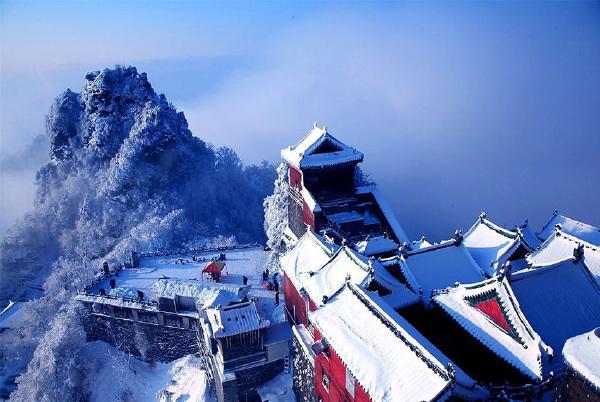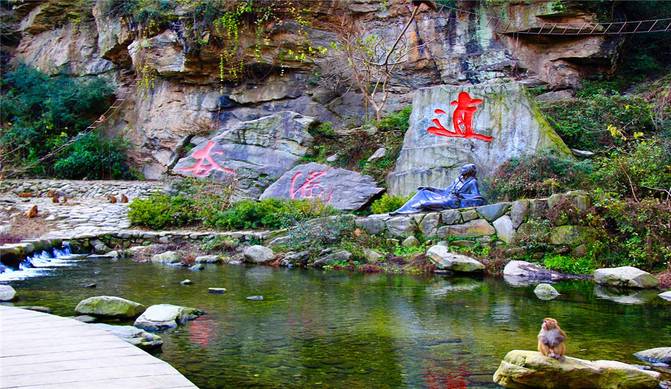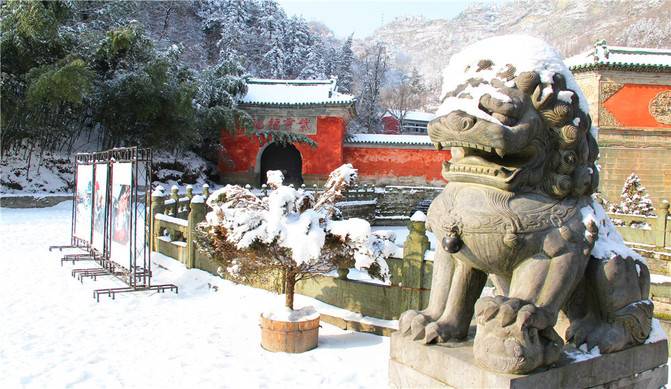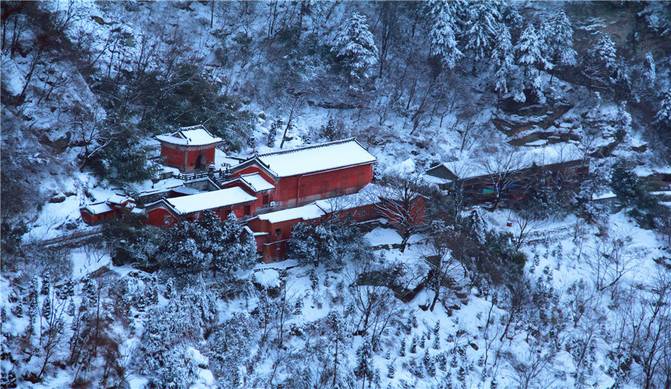Yuxu Palace Ruins
The 'Yuxu' praised in the famous Ming Dynasty writer Wang Shizhen's 'Yuxu is like Qin Afang' is located here. In Taoism, Yuxu refers to the residence of the Jade Emperor. During the Yongle period of the Ming Dynasty, Yuxu Palace was the largest temple in the Wudang Mountain royal temple complex. Unfortunately, it was almost completely destroyed by two fires and a mountain flood. In 2007, the main hall of Yuxu Palace was restored according to the principle of repairing the old as the old, and the restoration was completed in 2012. Although the existing ruins cannot fully display the grandeur of the past, they still offer a glimpse of its former majesty and sanctity.
Mozhen Well Village
Mozhen Well, also known as Chunyang Palace, is named because Wudang Taoism believes that at sunrise, this place first receives the purest yang energy. The main building of Mozhen Well is the Laomu Pavilion, which houses a statue of Zi Yuanjun grinding an iron pestle into a needle. The statue is simple and vivid, showcasing the beautiful legend of grinding an iron pestle into a needle, conveying the profound meaning that perseverance leads to success, and has influenced generations.
Taizipo Village
To reach the Taizipo Scenic Area, you first need to cross an ancient stone arch bridge with ornate railings, known as Fuzhen Bridge. Ascending the steps from Fuzhen Bridge, the gate of Taizipo comes into view. Taizipo is also known as Fuzhen Temple. Facing east and looking west, Taizipo is a rare form in the history of Chinese architecture. It is built on a 60-degree steep slope of Lion Peak and is praised by contemporary architects as a classic example of utilizing steep slopes for construction. Ancient master builders ingeniously used the mountain's terrain to construct the Nine-Bend Yellow River Wall, which undulates like waves along the mountainside, creating a spectacular sight. The main building of Taizipo is naturally the Fuzhen Temple Hall, built in the tenth year of the Yongle period of the Ming Dynasty and renovated in the same period. On it, you can see the majestic and solemn work of master builders from both the Ming and Qing Dynasties.
Xiaoyao Valley
Xiaoyao Valley is a tourist destination that integrates natural landscapes and animal ecology. The valley is home to a variety of animals, including monkeys roaming the jungle and black swans swimming among the lotus leaves, all adding to the fun. Xiaoyao Valley boasts green mountains and clear waters, with beautiful scenery. The new 'Heaven Sword and Dragon Saber' by Zhang Jizhong was filmed here.
Zixiao Palace
Zixiao Palace is located under the Zhanqi Peak in the northeast of Tianzhu Peak. It was named 'Zixiao Blessed Land' by Emperor Yongle of the Ming Dynasty because the surrounding mountains naturally form a treasure chair with two dragons playing with a pearl. The most impressive part of Zixiao Palace for me is the Zixiao Hall. It is the only remaining double-eaved, Xieshan-style wooden structure hall in Wudang Mountain, housing statues of Zhenwu and other deities. The beauty of Ming and Qing architecture is vividly displayed in it.
Nanyan Palace is surrounded by lush forests and steep peaks. On clear days, one can enjoy the spectacular mountain scenery, while during the rainy season, the mountains are shrouded in mist, creating a fairyland-like atmosphere. Each season offers its own unique beauty. There is a prime viewing platform at Nanyan Palace where one can take in the panoramic view of the palace. From this vantage point, the pavilions, terraces, and picturesque landscapes are breathtaking. The Nanyan Stone Hall stands on a cliff, yet it retains its majestic and impressive presence, showcasing extraordinary craftsmanship that leaves visitors in awe. Outside the Nanyan Stone Hall, on the sheer cliff, stands a carved dragon stone pillar with an incense burner at the top, known as the 'First Incense of the World - Dragon Head Incense.' Seeing it in person is truly astonishing.
Golden Summit
Leaving Nanyan Palace, I walked up the ancient divine path from Nanyan Temple to reach the Golden Summit. Climbing to the top of Tianzhu Peak, I finally saw the full view of the Golden Summit. The Golden Summit is the symbol and essence of Wudang Mountain. Its structure is rigorous and magnificent. Standing in front of the Golden Summit, looking into the distance, the majestic and beautiful scenery of Wudang Mountain comes into full view, and a feeling of sincere reverence arises spontaneously. It truly deserves the reputation of being a 'fairy mountain and jade pavilion.' I heard that during the thunderstorm season every summer, Wudang Mountain presents the spectacular sight of lightning striking the Golden Hall. I hope to have the chance to witness it next time.

















